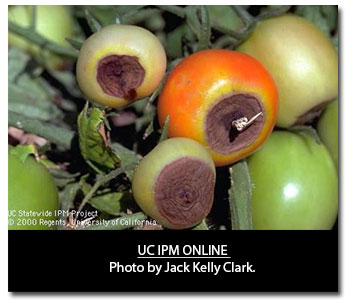Blossom End Rot and Your Tomatoes

Our Bacteria Friends Save the Day!
Blossom End Rot is a condition whereby the fruit of a tomato plant begins to rot at the bottom (at the blossom end, hence the name) before the fruit is fully ripe. It starts off as a small, watery spot at the base of the fruit but can grow to take over up to half of it. These spots eventually become dry and rubbery and the fruit is utterly unusable.
This is NOT a fungal disease or caused by any pathogen or pest. Therefore, it cannot spread from plant to plant, though many plants in the same bed might be affected. It cannot be controlled by any pesticide, organic or otherwise. There are a few potential causes of blossom-end rot but the solutions are not as straight-forward as some may think. However, with some care and repair, it is possible to remedy the root cause(s).
The biggest, most likely cause of Blossom End Rot is a lack of calcium in the plant. Notice that I said “in the plant”, not in the soil. The lack of calcium causes the fruit to rot before it’s ripe. There are many reasons that calcium is not getting into the plant. Occasionally, it is because there is not enough calcium in the soil; in which case that can be easily remedied with a calcium-laden soil amendment or even a dose of compost would likely help.
However, calcium is very common in most soils and is even in most tap water! It is more likely that the calcium is bound up in the soil and cannot get to the plants. This can be due to a number of factors:
- High salt content binds calcium (the negative ions in salt bind to the positive ions in calcium, keeping them both locked in the soil). High salt content is often caused by the use of conventional (non-organic) fertilizers.
- Bound calcium can also be caused by an imbalanced pH. If the pH is too acidic or alkaline, it throws off the rate at which calcium can be absorbed.
- Fluxuating soil temperatures can affect calcium absorption, particularly when the soil cools rapidly. A few inches of straw mulch can help stabilize soil temperatures from swinging too wildly one direction or the other.
The key to successfully unbinding calcium lies in the microbiology of the soil. A blooming, healthy microbial community will help to keep calcium and other micronutrients accessible to plants. Beneficial bacteria (and Bacillus species in particular) are adept at consuming bound nutrients and processing them into a usable form. They also balance pH and help to stabilize the salt content of the soil. To cure Blossom End Rot, I recommend adding a soil supplement that contains large amounts of Bacillus bacteria, like John and Bob’s Penetrate. There are a few other causes for Blossom End Rot, that all lead back to healthy bacteria. It can be caused by overwatering, which drowns the healthy aerobic populations of microorganisms. Conversely, underwatering can dry them out, past the survival point. So, it is important to keep the soil beneath the surface moist, but not too soaked, to maintain healthy populations.
If you have more questions or ideas about mid-season tomato care, drop me a line! You can find me on Facebook or contact me on my website! I always love to hear from you.
Article Coutesy of Steve Goto, Gotomato











